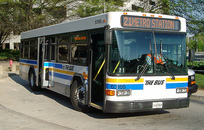WMATA, TheBus fail to coordinate Greenbelt bus schedules

Photo by Beechwood Photography on Flickr.
On Monday, WMATA and TheBus revised virtually every route serving the Greenbelt area. Some of the changes are positive. But instead of staggering departure times, multiple buses will leave almost at once and create unnecessarily long waits in between.
Old Greenbelt and Greenbelt East are now primarily served by 3 bus routes. Metrobus operates 2 of the routes, the G12 and the G13/G14/G16. Prince George’s County operates the third, TheBus route 11. Planners from WMATA and Prince George’s County worked together to devise routings that complimented each other and attempted to serve as many residents as possible.
But planners did not work together to devise schedules, and the result is a schedule which utterly fails to capitalize on investment. Poor scheduling is nothing new to Greenbelt, but this scheduling is actually worse than the schedules that existed prior to December 20.
As you can see from the chart, the buses are clustered in the schedule. This is especially true at Greenbelt Center (Crescent Road and Gardenway), where for almost the entire day, all three buses are scheduled to depart within 2 minutes of each other.
The Metrobuses are supposed to operate that way. As a part of simplifying Greenbelt’s bus service, Metro removed bus service from certain neighborhoods to other destinations. To solve this problem, Metro introduced a “timed transfer”. Westbound buses on route G12 meet westbound buses on route G13/G14/G16 at Greenbelt Center, where they have a scheduled 5 minute layover. The same is true for eastbound buses.
But TheBus route 11 operates over a route very similar to Metrobus G12. Since it serves the same neighborhoods as one of the timed transfer routes, it does not itself need to meet at the transfer point.
During rush hours, all 3 routes operate at 30 minute headways, so the ideal scheduling would be for Route 11 to be offset from the G12 and G13/G14/G16 departure by 15 minutes. That would give much of Old Greenbelt and Greenbelt East 15-minute bus service.
Instead, the failure of WMATA and Prince George’s County to coordinate means that Greenbelt will have 3 buses leaving at virtually the same time, with approximately 29 minutes between departures.
It appears that the failure to coordinate occurred because WMATA was not able to release finalized schedules until about a week before the new service began. Prince George’s County, not knowing when Metro’s buses would be running, scheduled their departures on the hour and on the half hour from Greenbelt Metro. They released their schedules to the public well before WMATA did.
As a result, when Metro finally released their schedules, it was too late for Prince George’s County to do anything.
Because of this snafu, the buses are going to cannibalize each others’ ridership, which is bad, since the old routes were already underperforming.
Prince George’s route 11 is the fastest way to get from Greenbelt East, Greenbelt Center, and the North End to the Metro, but it might not reap the gains it otherwise would’ve, because many riders don’t know as much about the TheBus system.
That’s a marketing problem, which will be exacerbated since riders will be able to chose between TheBus and Metrobus, with the same departure time. If the buses were offset by 15 minutes, riders might be more likely to just get on whichever bus came first.
The simplest solution would be for Prince George’s County to move their bus schedule for route 11 by 15 minutes in either direction. That would result in 15-minute headways parts of Greenbelt for rush hour, and would keep the half-hour headways in the off-peak that are currently scheduled wherever route 11 operates.
This failure to coordinate has resulted in substandard service for a densely populated part of Prince George’s with relatively good transit ridership. But not all is lost. A few simple scheduling changes could result in vastly improved bus service in the area, at no cost to either transit agency. And better bus service might mean more revenue in the form of new riders.

